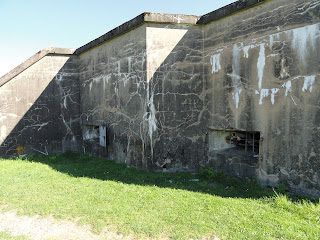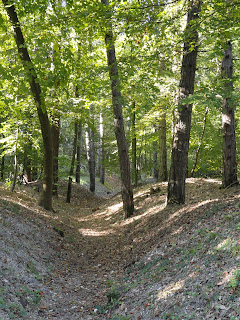Simple tributes to French soldiers who died defending these positions.
Back towards the southeast is Fort Vaux, part of the next line of French fortifications behind Fort Douaumont. The Germans assaulted it in June, and the French defense was epic in nature. The small garrison of 500 soldiers held on for five days against the German attacks, which included the use of poison gas and sappers with flamethrow
French and German soldiers fought each other for 5 days in these corridors.
A French 75mm field gun in Vaux. The "75" was the first modern quick-firi
Exterior shot of the same gun port.
More Exterior shots of Vaux.
These next two photos show the remnants of a gun turret, destroyed by a direct hit from artillery that set off demolition charges laid by the French. The French had intended to destroy the fort, then decided to defend it, lost it, and suffered thousands of casualties trying to get it back.
With Vaux taken, only one defensive line stood between the Germans and Verdun. This line, sitting on a ridge, included Fort Souville and the village of Fleury; if they could be seized, Verdun was doomed. Heavy fighting raged for weeks, but repeated German attacks failed and the French held on. Fleury changed hands 15 times and the village was totally destroyed. The French never rebuilt the place. Only grass, trees, monuments, plaques, and shell holes remain. Eight other villages around Verdun were totally destroyed during the battle and never rebuilt.
Markers like these were erected to represent the business or home structure that stood on the plot before the battle.
Aerial view of Fleury after the battle
"They did not pass." The monument at Mort-Homme (Dead Man) dedicated to the men of the French 69th Division who fell defending this area. The monument shows death wrapped in a shroud holding a flag and a flaming torch. The wording is a response to Marshal Philippe Petain's declaratio
The following photos are of a monument and some trenches on Mort-Homme
Trenches along Dead Man's Hill and Hill 304. The Germans suffered some 70,000 casualties trying to seize them. These woods were in 1916 described by soldiers who fought there and portrayed by the old black and white photos of the era as a lunar landscape, devoid of vegetation, pockmarked with the imprints of thousands of shell holes, and littered with the refuse of war. Walking through the peaceful forests in 2010, it was difficult to conceive the amount of death and destruction that men almost a 100 years ago were capable of inflicting on each other and their environment.
This shot shows that in some areas the amount of destruction continues to affect the area. Notice the trees are still stunted and scrub-like. The soil absorbed so many shells that it never completely recovered.
And here are a few shots of the battlefield the way it looked in 1916:
Very unique action shot of French troops going "over the top." Notice the absence of vegetation in the area to their front.
As I mentioned, our trip was short; less than a day because we intended to see a little of the area of the US Meuse-Argonne offensive of 1918 before darkness set in (for another entry so stay tuned). We missed a great deal, including the battlefield museum, Fort Souville, le bois de Caures (the start of the battle), le ravin de la mort (the valley of death)., and the Tranchee des Baionnettes (Bayonet Trench), where legend and myth has it that the remnants of a French infantry regiment still remain, buried alive under a hail of artillery fire. Indeed, one could easily spend several days, if not a week, touring the battlefield. We intend to go back....one day.










































I have always been a bad history student and know nothing of WWI, but after reading PART 1, (and now part 2) of the battle of Verdun,I found myself coming home with Jeff Shaara's "To the Last Man". Okay, so it's a historical NOVEL, but it's a start, and I still have flashbacks of past high school and college history teachers boring me to the point of teeth grinding. Thanks, T, for ressurecting WWI history out of my mental dumpster with your vivid posts....M.
ReplyDeleteThanks for the comment! Neither of us are experts on WW1, but the trip inspired me to go back and re-read Alistair Horne's Price of Glory which I had not touched in probably 10 years or more.
ReplyDelete